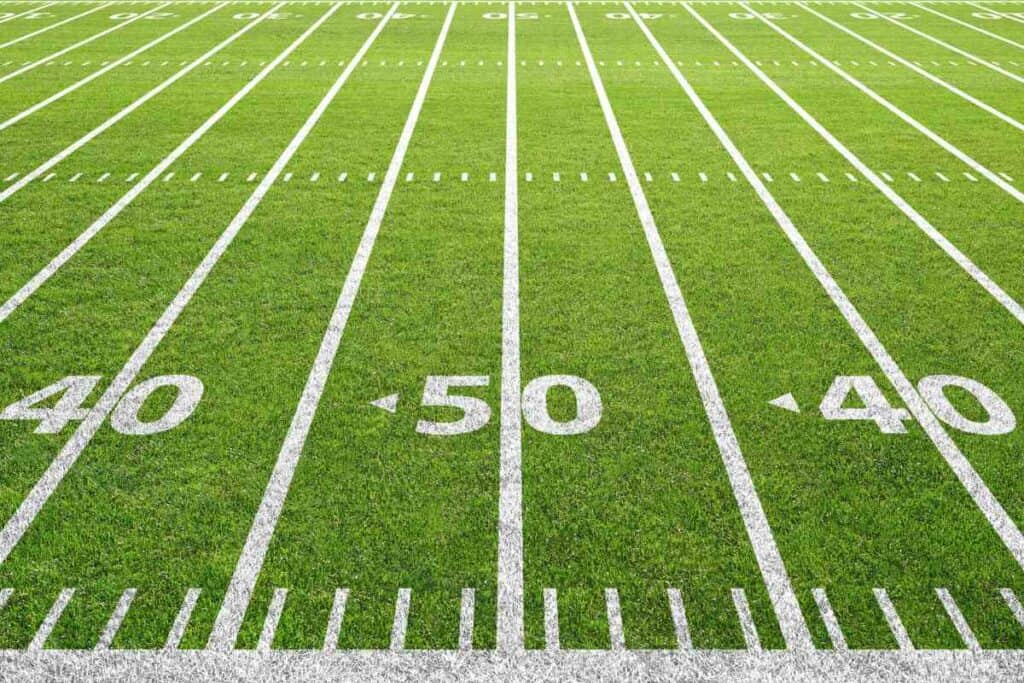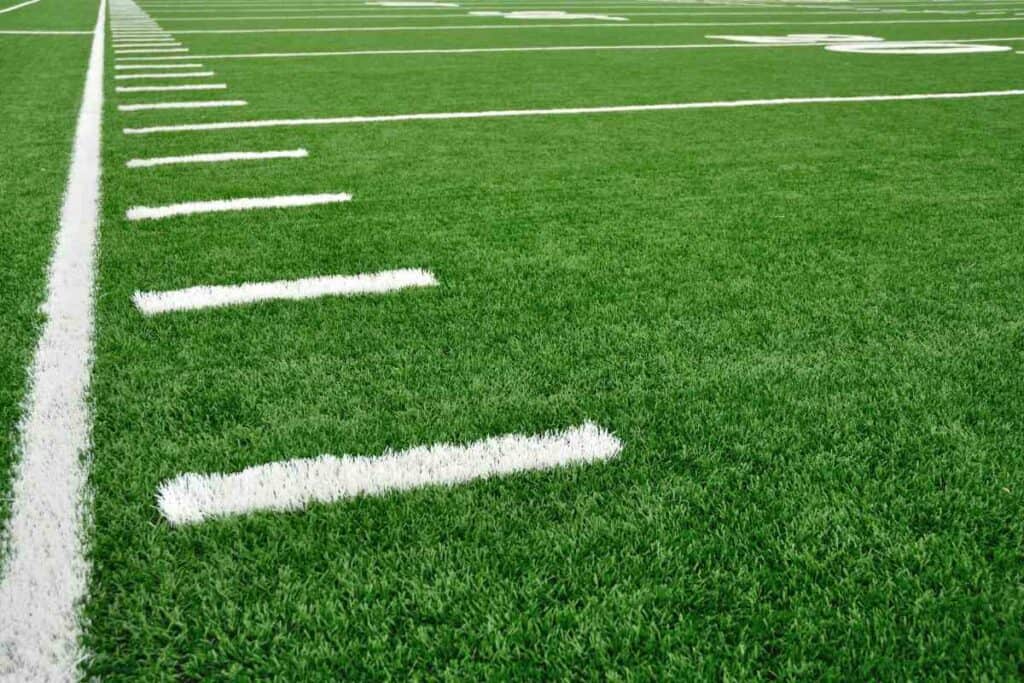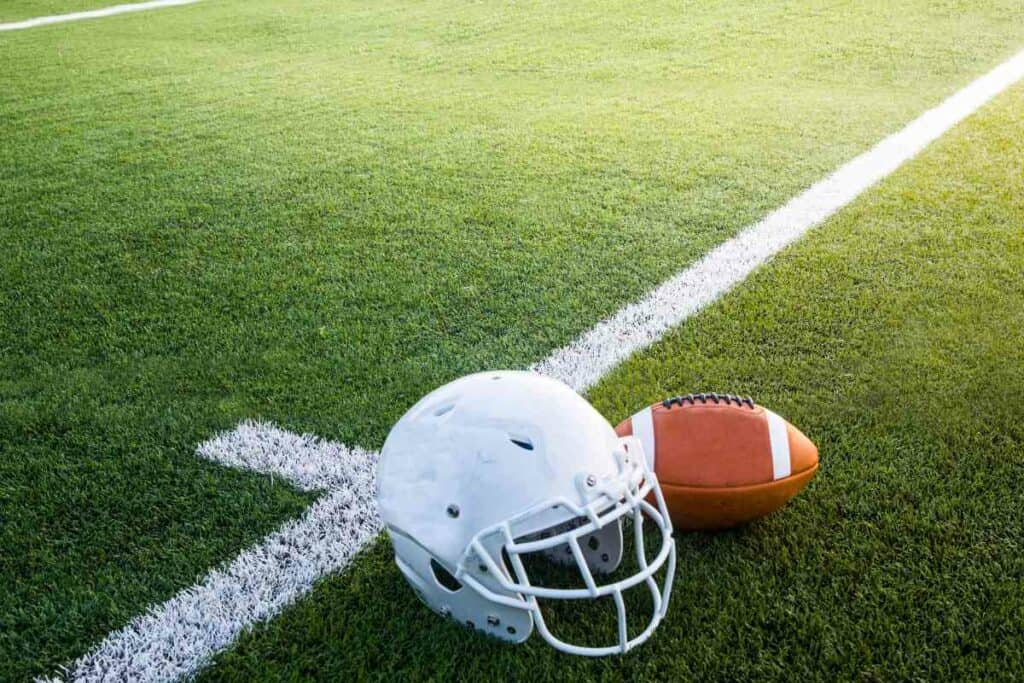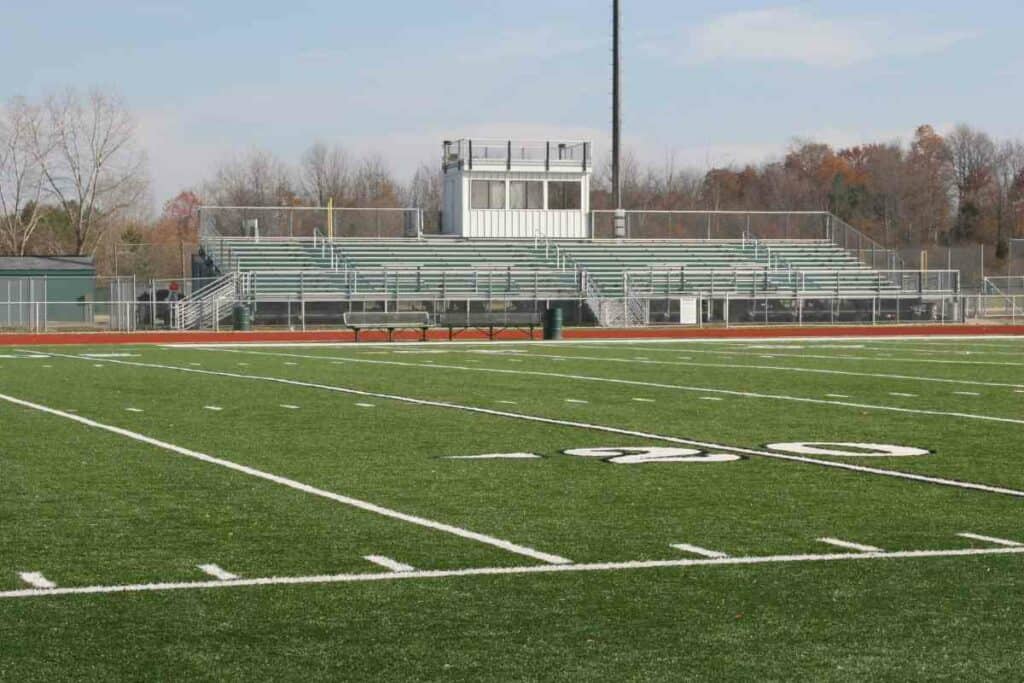What Size Is a High School Football Field? Dimensions and Regulations Explained
A high school football field is a rectangular playing surface used for American football games. It is important to know the dimensions of a high school football field if you are a player, coach, or spectator. The size of a high school football field is regulated by the National Federation of State High School Associations (NFHS).

Did you know most high school football fields can be rented for private events for small fee?
What Size Is a High School Football Field?
According to the NFHS, a high school football field is 100 yards long and 53 1/3 yards wide. The end zones are each 10 yards deep, and the field is marked with yard lines every 5 yards. The hash marks are located 60 feet from each sideline and are used to determine the placement of the ball for each play.
This is the same size as college football fields. The goal posts are located at the back of each end zone and are 23 feet, 4 inches apart.
Here is a table summarizing the dimensions of a high school football field:
- Length of Field: 100 yards
- Width of Field: 53 1/3 yards
- Length of End Zones: 10 yards each
- Distance Between Hash Marks: 60 feet
- Distance Between Goal Posts: 23 feet, 4 inches
Knowing the dimensions of a high school football field is essential for players, coaches, and spectators. It ensures that the game is played fairly and according to regulations. Whether you are a seasoned football fan or a newcomer to the sport, understanding the size of the field is an important part of enjoying the game.
Dimensions of a High School Football Field
When it comes to football, the size of the field can vary depending on the level of play. In high school football, the dimensions of the field are regulated by the National Federation of State High School Associations (NFHS). In this section, we will explore the dimensions of a high school football field.
Length
The length of a high school football field is 100 yards or 300 feet. This length includes two 10-yard end zones at each end of the field. This is the same size as the NFL. The end zones are areas where touchdowns are scored and are marked by white lines extending from sideline to sideline.
Width
The width of a high school football field is 160 feet or 53 1/3 yards. The field is divided into two equal halves by a midfield line, which is marked by a white line running the width of the field. The midfield line is also known as the 50-yard line.
To help players and officials know where they are on the field, there are hash marks on the field. In high school football, the hash marks are located 53 feet 4 inches from each sideline. This is different from college football, where the hash marks are located 60 feet from each sideline.
| Field Dimension | Measurement |
|---|---|
| Length | 100 yards |
| Width | 160 feet |
| End Zone Length | 10 yards |
| Hash Mark Length | 53 feet 4 inches |
The dimensions of a high school football field are 100 yards long and 160 feet wide, with two 10-yard end zones at each end. The hash marks are located 53 feet 4 inches from each sideline. Knowing the dimensions of the field is important for players, coaches, and officials to ensure a fair and safe game.

Yard Lines and Hash Marks
One of the most important aspects of a football field is the yard lines and hash marks. These markings help players and referees keep track of the ball’s position on the field, and they also help fans follow the game.
Yard Lines
Yard lines are marked every 5 yards on the field, beginning and ending 4 inches from the sideline. These lines are numbered to help players and referees identify the location of the ball. The numbers are typically white, measuring 6 feet in height and 4 feet in width, with the tops of the numbers nine yards from the sidelines.
Hash Marks
Hash marks are a set of parallel lines that run down the center of the field and mark every yard line. They are used to mark each down when the ball is between the yard lines. High school hash marks are 53’4″ from the sidelines, while NCAA hash marks are 60′ from the sidelines. Hash marks are 1 yard apart and are used to determine the placement of the ball on the field.
Table: Yard Lines and Hash Marks
| Entity | Description |
|---|---|
| Yard Lines | Marked every 5 yards on the field, beginning and ending 4 inches from the sideline. |
| Numbers | White, measuring 6 feet in height and 4 feet in width, with the tops of the numbers nine yards from the sidelines. |
| Hash Marks | A set of parallel lines that run down the center of the field and mark every yard line. High school hash marks are 53’4″ from the sidelines, while NCAA hash marks are 60′ from the sidelines. |
In conclusion, yard lines and hash marks are essential components of a football field. They help players, referees, and fans keep track of the ball’s position on the field. Understanding these markings is crucial for anyone who wants to follow the game of football.

End Zones and Goal Lines
The end zones in a high school football field are located at each end of the field. They are typically 10 yards deep, but some high schools may have end zones that are as short as 6 yards or as long as 15 yards. The goal lines are located at the back of each end zone and are the lines that a team must cross in order to score a touchdown.
The width of a high school football field is 53.3 yards, which includes the width of both end zones. The distance between the two goal lines is 100 yards or 300 feet. The entire width of each goal line shall be in the end zone.
In addition to the goal lines, there are other lines on the field that are important to understand. The 20-yard line, for example, is where the red zone begins. This is the area of the field where a team is within striking distance of the end zone and is more likely to score a touchdown. The 50-yard line is the center of the field and is where the game starts and restarts after halftime.
It’s also important to note that the goalposts are located at the back of each end zone, and they are 18 feet, 6 inches apart. The football goal crossbar is 10 feet high, and the posts are an additional 20 feet high, for a total height of 30 feet.
Here’s a table summarizing the dimensions of a high school football field:
| Entity | Dimension |
|---|---|
| End Zone Length | 10 yards |
| Goal Line Width | Entire width of the end zone |
| Field Width | 53.3 yards |
| Distance Between Goal Lines | 100 yards |
| Goalpost Width | 18 feet, 6 inches |
| Goalpost Height | 30 feet |
Understanding the dimensions of a high school football field is important for players, coaches, and fans alike. By knowing the size of the field and the location of important lines and markers, everyone can better appreciate the game.
Sidelines and End Lines

The sidelines and end lines are important dimensions of a high school football field. The sidelines run the length of the field, while the end lines are located at each end of the field. According to the National Federation of State High School Associations (NFHS), the sidelines and end lines must be at least 6 feet wide.
In addition to the minimum width requirement, the sidelines and end lines may exceed 4 inches in width, as per Rule 1-2-1-g. This means that the width of the sidelines and end lines may vary depending on the specific field.
To ensure safety and maintain consistency, the NFHS also mandates that twenty-four inch short yard-line extensions, four inches inside the sidelines and at the inbounds lines, are mandatory. This ensures that the players have a clear boundary for the field of play.
The following table summarizes the minimum dimensions for the sidelines and end lines on a high school football field:
| Entity | Minimum Dimension |
|---|---|
| Sidelines | 6 feet wide |
| End Lines | 6 feet wide |
It is important to note that these dimensions are the minimum requirements, and the actual width of the sidelines and end lines may vary depending on the specific field. However, the NFHS guidelines provide a baseline for ensuring safety and consistency on high school football fields.
Goal Posts

The goal posts on a high school football field are different from those found on college or professional fields. The National Federation of State High School Associations (NFHS) sets the standard for high school football fields, including the goal posts.
According to NFHS rules, high school goal posts are 23 feet 4 inches wide and 20 feet tall from the ground. The crossbar is 10 feet high, and the uprights extend an additional 10 feet above the crossbar, making the total height 30 feet. The goal posts are positioned at the back of each end zone and are centered on the end line.
It’s important to note that the width of high school goal posts is wider than those found on college or professional fields. This is to account for the lower skill level of high school kickers. A wider goal post makes it easier for them to make field goals.
Here’s a table to summarize the dimensions of high school goal posts:
| Goal Post Dimensions | Measurement |
|---|---|
| Width | 23 feet 4 inches |
| Height | 20 feet |
| Crossbar Height | 10 feet |
| Total Height | 30 feet |
It’s also worth noting that the hash marks on a high school football field are different from those on college or professional fields. The hash marks on a high school field are 53 feet 4 inches from the sidelines, while the hash marks on a college field are 60 feet from the sidelines.
Overall, the goal posts on a high school football field are wider and shorter than those found on college or professional fields. This is to account for the lower skill level of high school kickers.
Playing Field

The size of a high school football field is standardized and regulated by the National Federation of State High School Associations (NFHS). A standard high school football field is 120 yards long and 53.3 yards wide, which is equivalent to 360 feet long and 160 feet wide. The field is divided into two equal halves by the midfield line, which is located at the 50-yard line.
The football field is marked with various lines and markings, including the sidelines, end lines, goal lines, and hash marks. The sidelines run the entire length of the field and are located on the edges of the playing surface. The end lines are located at each end of the field and mark the boundaries of the end zones. The goal lines are located at the back of each end zone and mark the spot where a touchdown is scored.
The hash marks are located in the center of the field and are used to mark the spot where the ball is placed at the start of each play. In high school football, the hash marks are 53 feet, 4 inches apart, which is wider than the hash marks used in college and professional football. This means that the ball is placed closer to the center of the field for each play, which can affect the strategy and tactics used by teams.
In addition to the standard markings, high school football fields may also have additional markings to indicate the location of the team benches, the yard lines, and other important areas. These markings are typically painted on the field using special turf paint that is designed to withstand the wear and tear of football games.
Overall, the size and layout of a high school football field are carefully regulated to ensure a fair and competitive playing environment for all teams. The standardized dimensions and markings help to ensure that all players have an equal chance to succeed, regardless of the specific field they are playing on.
Football Sizes
Football sizes vary depending on the age of the players. Younger athletes use smaller footballs to accommodate their smaller hands, while high school, college, and professional players use full-sized footballs. Here are the different sizes of footballs used in football:

| Age Group | Football Size |
|---|---|
| 6-9 years | Pee Wee (Size 6) |
| 10-12 years | Junior (Size 7) |
| 12-14 years | Intermediate/Youth (Size 8) |
| High School, College, and Professional | Official (Size 9) |
The official football size used in high school, college, and professional football is size 9. It has a circumference of 21-22 inches and a weight of approximately 14-15 ounces. The smaller sizes, such as the Pee Wee and Junior sizes, have a smaller circumference and weight to accommodate younger players.
It’s important to note that football sizes are not standardized across all leagues and organizations. Some leagues may use slightly different sizes, so it’s important to check with your specific league or organization to ensure you are using the correct size football.
In addition to the size of the football, the texture and material of the ball can also vary. Many footballs are made of leather or synthetic materials, and some may have a textured surface to improve grip. The choice of football material and texture is often a matter of personal preference for the player.
Overall, understanding the different sizes of footballs used in football is important for players, coaches, and parents alike. By using the correct size football, players can improve their performance and reduce the risk of injury.
Conclusion
In conclusion, the size of a high school football field is standardized by the National Federation of State High School Associations (NFHS). The field is rectangular and measures between 100 and 120 yards long and 53 and 64 yards wide. The playing field is typically made of natural grass, although some newer fields have artificial turf.
The dimensions of a high school football field are slightly smaller than those of a college football field and significantly smaller than those of an NFL field. However, the playing area is still large enough to accommodate the 22 players on the field and provide ample space for running, passing, and kicking.
It is important to note that the dimensions of a high school football field may vary slightly depending on the state or region in which it is located. Therefore, it is always best to consult with local regulations to ensure that you have the correct dimensions for your particular field.
Overall, the size of a high school football field is designed to provide a safe and fair playing environment for student-athletes. By adhering to the NFHS guidelines, schools can ensure that their fields are properly sized and marked, allowing for consistent and competitive play.
